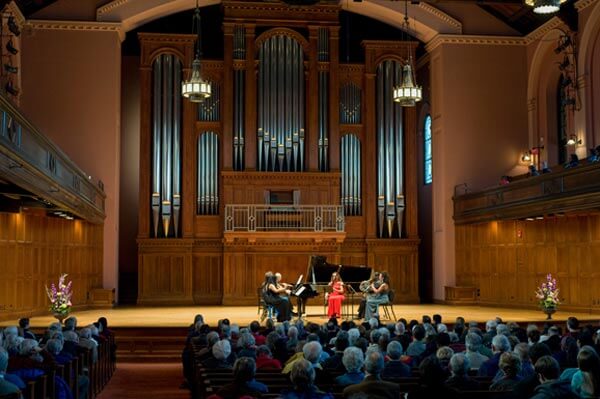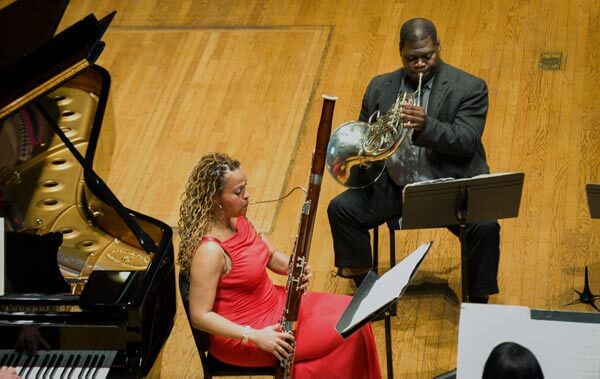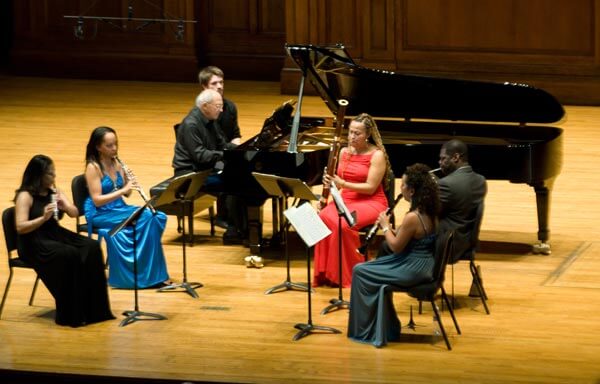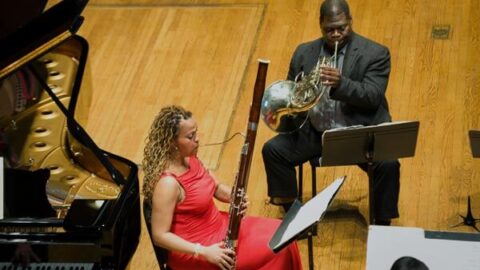 Imani Winds—Valerie Coleman (flute), Toyin Spellman-Diaz (oboe), Mariam Adama (clarinet), Jeff Scott (horn), and Monica Ellis (bassoon)—with guest pianist Gilbert Kalish presented a strikingly varied program at Oberlin College’s Finney Chapel on Sunday, February 9, 2014. Influences from contemporary to classical, from jazz to pop, permeated a performance full of heat and light, brightening a cold and dreary afternoon. The revelation on the program was Cane, by composer and jazz pianist Jason Moran, commissioned by Imani as part of their Legacy Commissioning Project, in which they seek works from composers of diverse musical background. The balance of the program featured 20th and 21st century works, with the exception of Mozart’s Quintet for Piano and Winds, K. 452, a last-minute choice to play one more piece featuring Kalish.
Imani Winds—Valerie Coleman (flute), Toyin Spellman-Diaz (oboe), Mariam Adama (clarinet), Jeff Scott (horn), and Monica Ellis (bassoon)—with guest pianist Gilbert Kalish presented a strikingly varied program at Oberlin College’s Finney Chapel on Sunday, February 9, 2014. Influences from contemporary to classical, from jazz to pop, permeated a performance full of heat and light, brightening a cold and dreary afternoon. The revelation on the program was Cane, by composer and jazz pianist Jason Moran, commissioned by Imani as part of their Legacy Commissioning Project, in which they seek works from composers of diverse musical background. The balance of the program featured 20th and 21st century works, with the exception of Mozart’s Quintet for Piano and Winds, K. 452, a last-minute choice to play one more piece featuring Kalish.

Cane commemorates Moran’s heritage in the Cane River region of Louisiana. Although clearly influenced by his jazz background and deep understanding of the threads of African American musical culture, Cane is not constructed of overt jazz riffs. It consists of four movements, each representing a period in his family’s journey from Africa, through Louisiana, and ultimately to New York. The first movement, “Togo to Natchitoches,” addresses the middle passage, the horrific journey on slave ships from Africa to the European colonies in North America. The music is somber with long, drawn-out notes, depicting the arduous trek. Spellman-Diaz’s plaintive line on the oboe was heart-wrenching. “Coin Coin’s narrative,” tells the story of Marie-Therese Coin, an African-born slave who was later freed in Louisiana. This movement takes on a lighter, lilting melody led by flute, oboe and clarinet over a deep low ostinato from bassoon and horn, depicting the many sides of life as a person enslaved, yet alive with hope for the future. “Gens libre de couleur,” the third movement, represents Coin Coin’s establishment of the first church for people of color and is the most optimistic. It’s alluring notes in call and response form, are full of sweet exchanges. The finale, “Natchitoches to New York,” shows the deepest connections to the jazz idiom, fast-paced with a complex rhythm. A duet by Scott and Ellis set a non-stop groove on horn and bassoon.

Another highlight of the afternoon was Imani’s masterful shredding of Stravinsky’s Rite of Spring in Jonathan Russell’s 2010 arrangement for wind quintet. After near-endless 2013 performances of various arrangements of the Rite celebrating its 100th anniversary, one might think we’d had enough. But Imani’s performance of this unique approach to the score brought forth nuances that, according to Spellman-Diaz’s tongue-in-cheek intro “are usually covered up by loud percussion and obnoxious brass.” It was like hearing the Rite again for the first time and left us craving to witness a contemporary dance performance to this arrangement.
It was clear that Imani and Kalish have forged a deep collective intuition over many collaborations. In Francis Poulenc’s brash Sextet for Piano and Winds (1932, revised 1940), they dazzled, deftly revealing all the colors and timbral nuances of the composer’s pleasantly dissonant lines raked at obtuse angles. It sounded as fresh as if it were written today. In the Mozart Quintet, a warhorse of the piano-wind ensemble repertoire if there is one, they played with élan and precision.

The program was bookended with with two short pieces from the hand of Scott. The opening Startin’ Somethin’, a Scott composition, is a high-speed romp of fitful starts and stops in a bustling traffic jam that limbered up the band and audience both. The finale, Scott’s wind quintet arrangement of Astor Piazzolla’s Libertango, has become almost a theme song for the group. Lending it a jazz-influenced structure, Scott’s version sets up a relentless bass platform in the bassoon to support a free exchange of the melodic lines by the other players in solos and various combinations. This bit of vibrant Buenos Aires sunshine was a welcome respite on a dank February afternoon in Ohio.
























